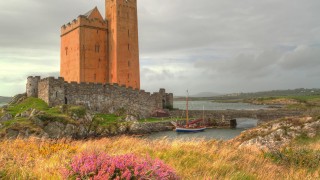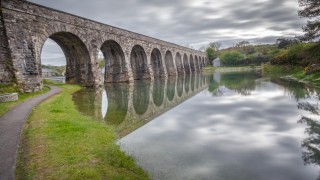
Ballydehob
To enter a different world, just break your journey at the southwest hingepoint of the N71 and stop at Ballydehob, a charming gateway to the Mizen peninsula.

Directions
Located on the N71, 99km west of Cork city, 16km from Skibbereen.
Special Areas of Conservation
Roaring Water Bay
From the east the village suddenly appears snuggled in the embrace of Mount Gabriel, the colourful gables reflecting the morning sun.
Before entering the village you will see a children’s playground on the left, shadowed by the elegant old railway viaduct with its 12 arches. Opposite you will find tennis and basketball courts. From the walkway over the viaduct the estuary seems filled with waders and wildfowl on the ebb tide.
Many charming walks and cycle routes touch the coastline in this area offering stunning views of the islands and the distant Fastnet Rock Lighthouse. In the waters beyond there is good fishing from charters boats, with a large variety of fish including several types of shark being caught.
In the village there is a public monument to Ballydehob’s most famous son – world wrestling champion Danno O’Mahony, who wrestled in Madison Square Gardens in the 1930s. Descendants of his family still live in the area and are very willing to regale you with anecdotes.
Ballydehob has a reputation of nurturing the Arts and is home to musicians, writers, artists, sculptors and craft workers in a variety of media. From many of the bars, the strains of traditional folk music can be heard at evening time. The village hosts a traditional music festival in spring every year.
Information courtesy of Schull Visitor Guide.
Discover the Locality
History
Ballydehob is a microcosm of Irish local history, and legends and folklore abound in the locality. At the dawn of the Bronze Age (2200-600 B.C.), copper was mined on Mount Gabriel, just west of the village. About the same time stone circles, wedge and boulder tombs were constructed in the area.
The Celts arrived at some later time and in the early historic period various clans fought for dominance, until the eventual emergence of the McCarthys and O’Mahonys as the rulers of the region. A string of castles along the coastline bear testament to their strength, and to the strategic importance of this area. Kilcoe Castle, near Ballydehob, was the McCarthy’s most westerly stronghold and their only coastal foothold; it is probably West Cork’s best preserved castle, which has in recent years been extensively restored by the actor Jeremy Irons.
In 1602 soldiers led by Sir George Carew, Lord President of Munster, descended on the area in a successful bid to break the power of the Gaelic chieftains.
The 17th century saw an influx of settlers mainly from England, but a significant number were Protestants (Huguenots) fleeing persecution in Catholic France. The Swantons from Norfolk emerged as the most prominent family in the locality, and by the late 18th century they had succeeded in changing the name of Ballydehob to Swanton’s Town. (The last known use of the name Swanton’s Town was in the census of 1821).
In the 1820s copper mining developed again in the region. The Cappagh mine, the most productive of several, was financed by Lord Audley; worked intermittently from 1814-1874 its 20 metre chimney survived until February 2002, when it was destroyed by a lightning strike. An interesting feature of this mining era was the introduction to Ballydehob of a police constabulary and barracks, some 6 years before the first London police force.
By the 1840s the population of the area had swelled to nearly 20,000. Then disaster struck when the potato crop failed and the Great Irish Famine resulted. This affected Ballydehob and the whole of West Cork in a most devastating way; thousands died and thousands more emigrated. Between 1841 and 1851 the population of the area fell by 42%, a decline which was much higher than the national average. At present Ballydehob has a resident population of 200.
On 6 September 1886 Ballydehob railway station opened on the narrow gauge Schull and Skibbereen Railway with a huge sports event held in Ballydehob to mark the occasion. At the time there was a 15 m.p.h. speed limit on the railway. The magnificent 12 arch bridge, which dominates the estuary of Ballydehob, was the major engineering achievement of the line. Mounting losses, coal shortages and the arrival of buses and motor cars eventually brought the closure of the line. The final train ran on 27 January 1947 and the station finally closed on 1 June 1953. Ballydehob was the main intermediate station on the railway.
Things to do
Gortnagrough Museum
A hidden gem in the area is Gortnagrough Museum. Located just off the N71, about 2.5 miles from Ballydehob Bridge, this will take you on a trip down memory lane. Younger children will be fascinated at the implements their great-grandparents had to use in olden days for everyday tasks. Every room in the home is on show and for budding environmentalists the old farmyard is a must.
Opening times: 11am – 6pm (Monday to Saturday), 2pm – 6pm (Sunday).
Admission €2.50 per adult, €1 per child, or €8 for a family.
Horse Riding
There are a number of riding centres in the local area to choose from. On horseback is one of the best ways to explore local beaches and countryside.
Swimming
Audley Cover is a pretty little stoney beach, which is ideal for swimming on a hot summers day and widely used by locals and visitors. Located south of Ballydehob.



